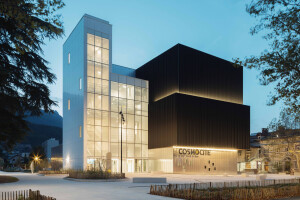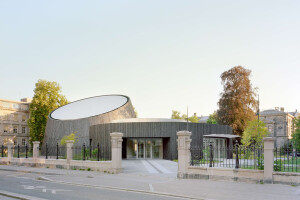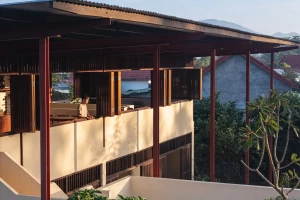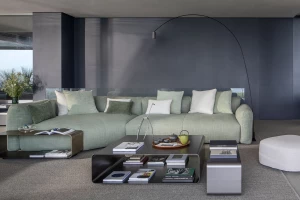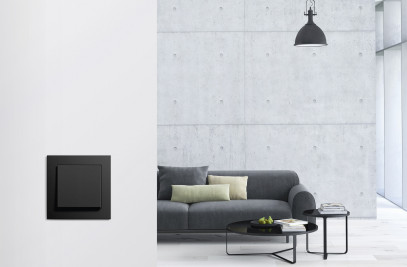Beijing-based Open Architecture has completed the Sun Tower, a waterside cultural facility in the Chinese port city of Yantai. The asymmetrical and conical concrete tower appears to have been sliced open, revealing its inner contents and structure. Recalling the age-old practice of sun worship, the Sun Tower is described by Open Architecture as a “cultural lighthouse”, where ancient wisdom and respect for nature integrate with contemporary urban living.
Archeological endeavors show Yantai to be one of the earliest places in China where people worshipped the sun. Open Architecture designed the Sun Tower as a way of celebrating the sun as a natural and life-sustaining entity. The tower “re-establishes people’s connection with nature’s spiritual power while bringing much-needed cultural and communal facilities to the new urban district,” explains Open Architecture.
The Sun Tower is a project for the Yantai Economic and Technological Development Area (YEDA), a national development zone in China. A one-time industrial district, the local municipality wishes to improve overall quality of life for a rapidly growing population: the new Sun Tower provides both a cultural boost and enhances Yantai’s waterfront area.
The 50-meter-tall (164-feet-tall) Sun Tower’s unique architecture follows the path of the sun throughout the year and acts like a huge sundial. “The geometry of the Sun Tower is sculpted by the movement of the sun observed from the vantage point of the site,” says Open Architecture.
The northern edge of the building’s outer shell is parallel to the sun’s movement at noon during the equinoxes (when both the northern and southern hemispheres experience equal amounts of day and night). On the summer solstice, the outdoor theater’s axis points towards sunrise over Zhifu Island (a place of historical significance); at noon on the summer solstice, the roof’s circular outline lies on a plane perpendicular to the midday sun. On the winter solstice, the entrance tunnel aligns with sunset.
The Sun Tower, a composite shell structure, was constructed in conjunction with engineering firm Arup: two layers of white concrete shells are connected and braced by horizontal slabs and ramps. The building is punctuated by a number of circular windows that direct light into the interior and improve ventilation. Facing the Yellow Sea, “the concave inner shell of the building acts as a sound collector, absorbing and amplifying sounds from the sea,” says Open Architecture.
At the tower’s base, a semi-circular theater provides a space for performances, relaxation, and people watching. The top of the tower houses a library and “Phenomenon Space” — an undefined void, this space frames a view of the sea. An oculus in the roof allows rainwater to be captured in a small pool, creating a serene water feature: “The water in the pool swirls for 9 minutes every hour, from 5 am to 9 pm, working as a special time device,” says Open Architecture.
In the middle of the building, positioned between the inner and outer shells, is a Digital Exhibition Space that zigzags upwards along a series of pedestrian ramps.
The majority of the Sun Tower’s spaces are not air-conditioned during the summer months. The building’s design utilizes passive strategies to maintain interior comfort and reduce energy consumption. Strategies include: the use of thermal mass to regulate fluctuations in indoor temperature, cross ventilation, and a chimney effect to drive airflow through the building, pushing hot air out and drawing cool air in.
The Sun Tower sits on a seashell-shaped plaza — the tower’s footprint and the outdoor theater’s stage area complete a full circle. When not in use for performances, the stage becomes a pleasing and misty water fountain.
A series of elliptical rings, resembling planetary orbits, radiate outwards from the center of the plaza. “A water channel, tangent to the tower and carved into the stone plaza, marks the passing of time on the equinoxes — the shadow of the tower’s northern edge moves exactly along the channel, intersecting each elliptical ring on the hour,” explains Open Architecture.
Open Architecture conceived the Sun Tower as a cultural lighthouse and a way in which to reconnect people with nature in a dense urban environment. “Nature has always been there. The difference is how we see it and how we coexist with it on this planet,” says the studio.
Sun Tower’s built area: 4,960 square meters (53,389 square feet)
Site area: 9,850 square meters (106,025 square feet)





































